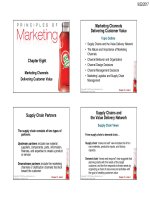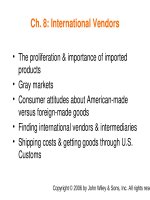Lecture E-Commerce - Chapter 8: Building e-commerce web sites (part III)
Bạn đang xem bản rút gọn của tài liệu. Xem và tải ngay bản đầy đủ của tài liệu tại đây (1.12 MB, 30 trang )
CSC 330 E-Commerce
Teacher
Ahmed Mumtaz Mustehsan
GM-IT CIIT Islamabad
•
•
Virtual Campus, CIIT
COMSATS Institute of Information Technology
•
T1-Lecture-8
Building E-Commerce Web Sites
Chapter-3
Part-III
T1-Lecture-8
For Lecture Material/Slides Thanks to:
Copyright © 2010 Pearson Education, Inc
Objectives
Understand
the issues involved in choosing the most
appropriate hardware for an e-commerce site.
Rightsizing Hardware Platforms for the site.
Rightsizing e commerce connections
Identify additional tools that can improve Web site
performance.
T1-Lecture-8
Ahmed Mumtaz Mustehsan
Copyright © 2010 Pearson Education, Inc
1-3
Merchant Server Software Packages
Integrated environment with most or all of functionality
needed:
Functionality.
Support for business models
Business process modeling tools
Visual site management and reporting
Performance and scalability
Connectivity to existing business systems
Compliance with standards
Global and multicultural capability
Local sales tax and shipping rules
T1Lecture6 Ahmed Mumtaz Mustehsan Copyright © 2010 Pearson Education, Inc
1-4
Building Your Own E-commerce Site
Options for small firms
Site building tools
◦E-commerce templates (open template)
◦Open-source merchant server software enables you
to build truly custom site, requires programmer with
expertise, time.
Cloud
Computing; Software and Hardware as service
Host
e-commerce site; Yahoo’s Merchant Solutions; or
colocation your servers at ISP; establish your own NOC;
T1Lecture8 Ahmed Mumtaz Mustehsan Copyright © 2010 Pearson Education, Inc
1-5
Choosing the Hardware for an
E-commerce Site
Hardware platform:
Underlying computing equipment that system uses to
achieve e-commerce functionality
Objective:
Enough platform capacity to meet peak demand
without wasting money
Important
to understand the different factors that affect
speed, capacity, and scalability of a site
T1Lecture8 Ahmed Mumtaz Mustehsan Copyright © 2010 Pearson Education, Inc
1-6
Right-Sizing Your Hardware Platform:
The Demand Side
Demand is the most important factor affecting
speed of site
Factors in overall demand:
Number of simultaneous users in peak periods
Nature of customer requests (user profile)
Type of content (dynamic versus static Web pages)
Required security
Number of items in inventory
Number of page requests
Speed of legacy applications
T1Lecture8 Ahmed Mumtaz Mustehsan Copyright © 2010 Pearson Education, Inc
1-7
Rightsizing E-Commerce Platforms
T1Lecture8 Ahmed Mumtaz Mustehsan Copyright © 2010 Pearson Education, Inc
1-8
Degradation in Performance as
Number of Users Increases—Resource Utilization
As the number of concurrent users (N) rises, the transaction rate (T)
rises linearly until an inflection point (X) is reached, after which
performance falls at a nonlinear rate until a crash is experienced.
T1Lecture8 Ahmed Mumtaz Mustehsan Copyright © 2010 Pearson Education, Inc
1-9
Degradation in Performance as
Transaction Latency vs Resource Utilization
(b) Likewise, latency increases to a point where it becomes exponential
and service quality is unacceptable.
T1Lecture8 Ahmed Mumtaz Mustehsan Copyright © 2010 Pearson Education, Inc
110
The Relationship of Bandwidth to Hits
The greater the bandwidth available, the more customers can simultaneously
access a Web site without any perceived degradation in performance.
T1-Lecture-8
Ahmed Mumtaz Mustehsan
Copyright © 2010 Pearson Education, Inc
111
Right-Sizing Your Hardware Platform:
The Supply Side
Scalability:
Ability of site to increase in size as demand increases
Ways to scale hardware:
1. Vertically
Increase processing power of individual components
2. Horizontally
Employ multiple computers to share workload
3. Improve processing architecture (Hybrid Approach)
Is a combination of vertical and horizontal scaling,
combined with artful design decisions
T1Lecture8 Ahmed Mumtaz Mustehsan Copyright © 2010 Pearson Education, Inc
112
Proposed Techniques for Scalability
T1Lecture8 Ahmed Mumtaz Mustehsan Copyright © 2010 Pearson Education, Inc
113
1. Vertically Scaling a System
T1Lecture8 Ahmed Mumtaz Mustehsan Copyright © 2010 Pearson Education, Inc
114
2. Horizontally Scaling a System
The Lightweight
Directory
Access
Protocol
(LDAP) is a
directory
service.
LDAP is an
open protocol,
and
applications are
independent of
the of server
platform
hosting
the directory
T1Lecture8 Ahmed Mumtaz Mustehsan Copyright © 2010 Pearson Education, Inc
115
3. Improve processing architecture
T1Lecture8 Ahmed Mumtaz Mustehsan Copyright © 2010 Pearson Education, Inc
116
Other E-Commerce Site Tools
Web site design: Basic business considerations
Enabling customers to find and buy what they need
Tools for Web site optimization:
Search engine placement
◦Meta-tags, page titles, content, keywords
◦Identify market niches, localize site
◦Expertise
◦Links
◦Search engine ads
T1Lecture8 Ahmed Mumtaz Mustehsan Copyright © 2010 Pearson Education, Inc
117
E-commerce Web Site Features
that Annoy Customers
SOURCE: Based on data from
Hostway Corporation’s survey,
Consumers’ Pet Peeves about
Commercial Web Sites, Hostway
Corporation, 2007.
T1Lecture8 Ahmed Mumtaz Mustehsan Copyright © 2010 Pearson Education, Inc
118
T1Lecture8 Ahmed Mumtaz Mustehsan Copyright © 2010 Pearson Education, Inc
119
Developing a Mobile Web Presence
Planning and building mobile presence
As
with regular Web site, use systems analysis/design to identify
unique and specific business objectives
Copyright © 2012 Pearson Education, Inc.
Slid
e 4
20
Developing a Mobile Web Presence
Two more features
Design Consideration
Three types of mobile e-commerce software
(Performance and cost)
◦Mobile Web site
◦Mobile Web app
◦Native app
Copyright © 2012 Pearson Education, Inc.
Slid
e 4
21
Developing a Mobile Web Presence
Design considerations
Platform constraints: Smartphone/tablet
Software : (Performance and cost )
Mobile Web site:
◦Least expensive
Mobile app:
◦Can utilize browser API
Native app:
◦Most expensive; requires more programming
Copyright © 2012 Pearson Education, Inc.
Slid
e 4
22
Tools for Interactivity and Active Content
Web 2.0 design elements:
Web
2.0 refers to the transition from static HTML Web pages to a
more dynamic Web that is more organized and is based on serving
Web applications to users.
Web 2.0 is the term given to describe a second generation of the
World Wide Web that is focused on the ability for people to
collaborate and share information online.
Importantly Web 2.0 includes open communication with an
emphasis on Web-based communities of users, and more open
sharing of information.
Over time Web 2.0 is being used more as a marketing term than a
computer-science-based term.
Blogs, wikis, and Web services are all seen as components of
Web 2.0.
T1Lecture8 Ahmed Mumtaz Mustehsan Copyright © 2010 Pearson Education, Inc
123
Designing for Accessibility in a
Web 2.0 and Mobile World
How
can Web sites be made more accessible?
Should
all Web sites be required by law to provide
“equivalent alternatives” for visual and sound content?
To facilitate disables.
What
additional accessibility problems do mobile
devices pose?
Copyright © 2012 Pearson Education, Inc.
Slid
e 4
24
Tools for Interactivity and Active Content
CGI (Common Gateway Interface)
A set of standards for communication between a browser
and a program running on a server that allows for
interaction between the user and the server
ASP (Active Server Pages)
a proprietary software development tool that enables
programmers using Microsoft’s IIS package to build
dynamic pages
Java
a programming language that allows programmers to
create interactivity and active content on the client
computer; thereby saving considerable load on the server
T1Lecture8 Ahmed Mumtaz Mustehsan Copyright © 2010 Pearson Education, Inc
125









